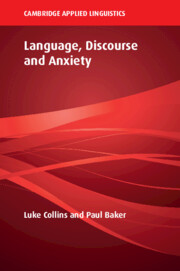171 results
XAS Study of Fe Mineralogy in a Chronosequence of Soil Clays Formed in Basaltic Cinders
-
- Journal:
- Clays and Clay Minerals / Volume 58 / Issue 6 / December 2010
- Published online by Cambridge University Press:
- 01 January 2024, pp. 772-782
-
- Article
- Export citation
We need to talk about values: a proposed framework for the articulation of normative reasoning in health technology assessment
-
- Journal:
- Health Economics, Policy and Law / Volume 19 / Issue 2 / April 2024
- Published online by Cambridge University Press:
- 27 September 2023, pp. 153-173
-
- Article
-
- You have access
- Open access
- HTML
- Export citation
Chapter 2 - Letters
- from Part I - Life and Works
-
-
- Book:
- Wilkie Collins in Context
- Published online:
- 27 July 2023
- Print publication:
- 10 August 2023, pp 11-18
-
- Chapter
- Export citation
Contents
-
- Book:
- Language, Discourse and Anxiety
- Published online:
- 08 June 2023
- Print publication:
- 22 June 2023, pp vii-viii
-
- Chapter
- Export citation
References
-
- Book:
- Language, Discourse and Anxiety
- Published online:
- 08 June 2023
- Print publication:
- 22 June 2023, pp 242-258
-
- Chapter
- Export citation
1 - Anxiety, Online Fora and This Study
-
- Book:
- Language, Discourse and Anxiety
- Published online:
- 08 June 2023
- Print publication:
- 22 June 2023, pp 1-28
-
- Chapter
- Export citation
4 - Creating a Community
-
- Book:
- Language, Discourse and Anxiety
- Published online:
- 08 June 2023
- Print publication:
- 22 June 2023, pp 96-134
-
- Chapter
- Export citation
2 - Sketching Anxiety
-
- Book:
- Language, Discourse and Anxiety
- Published online:
- 08 June 2023
- Print publication:
- 22 June 2023, pp 29-61
-
- Chapter
- Export citation
Copyright page
-
- Book:
- Language, Discourse and Anxiety
- Published online:
- 08 June 2023
- Print publication:
- 22 June 2023, pp vi-vi
-
- Chapter
- Export citation
6 - Comparing Cultures
-
- Book:
- Language, Discourse and Anxiety
- Published online:
- 08 June 2023
- Print publication:
- 22 June 2023, pp 166-190
-
- Chapter
- Export citation
8 - Conclusion
-
- Book:
- Language, Discourse and Anxiety
- Published online:
- 08 June 2023
- Print publication:
- 22 June 2023, pp 228-241
-
- Chapter
- Export citation
Tables
-
- Book:
- Language, Discourse and Anxiety
- Published online:
- 08 June 2023
- Print publication:
- 22 June 2023, pp x-xi
-
- Chapter
- Export citation
Index
-
- Book:
- Language, Discourse and Anxiety
- Published online:
- 08 June 2023
- Print publication:
- 22 June 2023, pp 259-262
-
- Chapter
- Export citation
3 - The Lived Experience
-
- Book:
- Language, Discourse and Anxiety
- Published online:
- 08 June 2023
- Print publication:
- 22 June 2023, pp 62-95
-
- Chapter
- Export citation
5 - Sex and Gender
-
- Book:
- Language, Discourse and Anxiety
- Published online:
- 08 June 2023
- Print publication:
- 22 June 2023, pp 135-165
-
- Chapter
- Export citation
Figures
-
- Book:
- Language, Discourse and Anxiety
- Published online:
- 08 June 2023
- Print publication:
- 22 June 2023, pp ix-ix
-
- Chapter
- Export citation
Preface
-
- Book:
- Language, Discourse and Anxiety
- Published online:
- 08 June 2023
- Print publication:
- 22 June 2023, pp xiii-xiv
-
- Chapter
- Export citation
Acknowledgements
-
- Book:
- Language, Discourse and Anxiety
- Published online:
- 08 June 2023
- Print publication:
- 22 June 2023, pp xii-xii
-
- Chapter
- Export citation
7 - Time
-
- Book:
- Language, Discourse and Anxiety
- Published online:
- 08 June 2023
- Print publication:
- 22 June 2023, pp 191-227
-
- Chapter
- Export citation

Language, Discourse and Anxiety
-
- Published online:
- 08 June 2023
- Print publication:
- 22 June 2023



